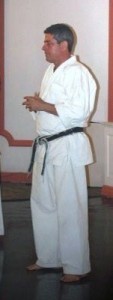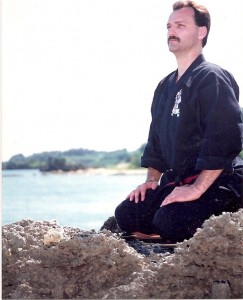Where do we go from here?
The following is an article submitted by a guest author, Manny Saavedra, Hanshi. He is the HeadMaster and Founder of the World Sansei GoJu organization, headquartered in Miami, Florida. He is one of the Senior Masters who’s roots began in USA GoJu as a student of GrandMaster Peter Urban. He founded the Sansei GoJu organization in 1979 at the same time I began my work on A.G.K.A.I. and has established one of the most credible GoJu-ryu international organizations in the world. I am blessed to call him my friend and GoJu brother.
We are honored to have him as a guest author at MARTIAL ARTS INSIDER, and I am blessed to benefit from the wisdom of his counsel. Please enjoy the article and feel free to comment and/or pose questions at the end in the comment section after this article. Our BLOG is set up to be interactive and he will be able to respond directly to any inquiry as his busy schedule permits.
SHIHAN RIC PASCETTA
…the first appearance deceives many; the intelligence of a few perceives what has been carefully hidden.
As a visual reference, a family tree is an excellent way to think about the connections between individuals, especially in large families. Historians often create a family tree, especially when they are looking at the history of royal dynasties, to follow the paths of allegiance and relation between various nations. A family tree can illustrate what exactly a second cousin is, for example, or show you the precise relationship between yourself and your step-great-aunt. In historical situations where families have tended to intermarry, a family tree can sometimes get confusing, and the linear nature is corrupted by lines which appear to sprout in all directions. So it is that we do the same in Karate.
For us in karate, a family tree showcases the connections and history of a family system. Most of us are proud of their relationships to famous these figures, and are delighted to have a family tree illustrating that point. The family tree can serve as a small history lesson of the family, showing the various origins of different members of the family, along with the children (students) they had and when they lived. It can also serve as a memory prompt, because seeing the family member’s name can bring out other pieces of the individual’s history, such as what he or she did that was distinctive or remarkable.
The Art above the Artist
For a tree to proliferate the branches must grow to gather nutrients for the trunk. There are no favorite branches and all are loved, all are part of the living tree. Some branches will survive the winter, some the rain, some will bend with the wind and some will break. Some of the branches will plant seeds. All are needed and are viewed as part of the one, part of the Toa, the natural order of life. It is within this natural order of life that all things must follow, and we as USA Goju lineage must learn to work together one way or another. (more…)
“Secrets of the Masters” – the Three Primary Conditions
“When life hands you lemons, make lemonade…”
As we proceed through life, each of us passes through similar stages of development. We can further subdivide each of these stages to examine Physical Development, Intellectual Development, Emotional development, and Spiritual development. These four “pillars” are the figurative “legs” that support the particular “table” that constitutes each of our lives.
For the serious Martial Artists, the overall journey ultimately becomes a quest to achieve “balance” in each area of development. This “quest” particularly distinguishes the difference between a “Martial Artist” and a “Martial Technician”. A Martial Artist must also be a Martial Technician, however, a Martial Technician is not necessarily a Martial Artist.
This concept of balance is pursued further by the contrasting and integration between all four of these interdependent facets. The role of the MA Master is to create an atmosphere in the Dojo, along with pertinent activities, that provide a fertile environment for development of each of these four pillars. (more…)
“Secrets of the Masters” – Clear Vision
“The knife cuts but it cannot cut itself; the eye sees, but it cannot see itself.”
As our individual lives unfold we begin to amass a volume of knowledge. This is a combination of “Firsthand Knowledge” along with much “Secondhand Knowledge”. I personally define “firsthand knowledge” as information that we assimilate and process further through personal experience. This is the “been there, done that” type of information that weighs heavily on our overall concept of life.
In contrast, I define “secondhand knowledge” as information we glean from other sources. Those sources begin with our family (mother, father, siblings, etc.) and then friends, associates, and later, teachers/mentors (in a more formal way). Less direct sources may include written, audio, or video material. In my opinion, it is extremely important to accurately and critically identify the source of all secondhand knowledge when weighing its credibility.
When weighing the credibility of firsthand knowledge we each have a greater tendency to give this information automatic credibility. This may well occur because our perspective of life is established on the basis of what is seen through the lens of our own eyes, not through the eyes of others. It is critical to remember that the validity of the conclusions drawn from processing any information is a function of the original and underlying premise or premises. (more…)
“Secrets of the Masters” – Seeking vs Finding
“….When someone is seeking it happens quite easily that he only sees the thing he is seeking; that he is unable to find anything;
unable to absorb anything because he is only thinking of the thing he is seeking, because he has a goal, because he is obsessed with his goal.
Seeking means: to have a goal; but finding means: to be free, to be receptive, to have no goal.”
-Siddhartha
In the above quote the famous philosopher, Siddartha, contrasts “seeking” with “finding” and seems to imply that in some manner the previous cancels the latter.
In my own life I have been inspired to make it a quest to “seek the truth”. Following the logic of Siddhartha, however, would (more…)


